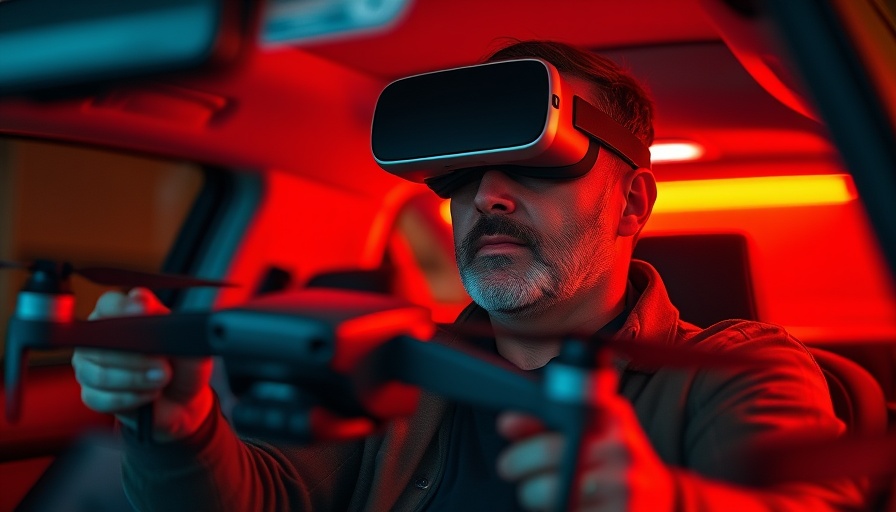
Phoenix PD Deploys Robotic Dog 'Spot' to Elevate Safety in Haute Policing


How LAPD's Mobile-First Approach is Revolutionizing Policing.
Update Revolutionizing Policing Through Digital Connectivity In an era where smartphones dominate daily life, the Los Angeles Police Department (LAPD) exemplifies how a mobile-first approach can redefine modern law enforcement. The LAPD has taken bold steps to embrace mobile technology, integrating devices ranging from smartphones to tablets into the daily operations of its officers. This paradigm shift reflects a deeper necessity for police to operate effectively in a highly connected world, underscoring the importance of fostering community relationships and enhancing operational capabilities. The Importance of a Mobile-First Mindset Shifting to a mobile-first mindset is more than a technological switch; it’s a strategic transformation aimed at improving efficiency and service delivery. For the LAPD, equipping officers with smartphones and connecting them to the FirstNet broadband network represents a conscious effort to modernize policing. As police agencies recognize that traditional radios and mobile data terminals (MDTs) are becoming outdated, the mobile device emerges as a key tool for ensuring effective communication. Untethered from Tradition: Navigating Modern Challenges The LAPD’s choice to utilize FirstNet for their communication infrastructure highlights a crucial aspect of modern policing: reliability. This network, created specifically for first responders, ensures that LAPD officers can communicate seamlessly, even during peak usage times when regular networks may falter. With features like priority access and preemption, FirstNet empowers officer connectivity, proving invaluable in maintaining public safety during crises. Enhancing Community Engagement Through Mobility As officers leverage mobile technology, the benefits extend directly to their interactions with the community. One particularly noteworthy implication is the ability to complete forms and paperwork in the field, allowing officers to spend less time tethered to police stations and more time connecting with local residents. This 'on-the-go' paperwork approach fosters trust, encouraging productive dialogues between law enforcement and citizens. The LAPD’s commitment to reducing bureaucracy and enhancing visibility reflects a broader trend that could lead to more engaged and informed communities. Real-Time Data Sharing: A Game-Changer for Law Enforcement There’s no denying that data is the lifeblood of informed decision-making. By transitioning to mobile technologies, the LAPD enhances its capability to capture, share, and act on data in real-time. A pertinent example includes immediate access to critical information during emergencies, ensuring that an officer’s situational awareness is informed and precise. Moreover, the increased transparency facilitated by real-time data can create a stronger foundation of trust between law enforcement and the community. The Road Ahead: Future Trends in Policing As the LAPD continues to iterate on its mobile-first approach, it sets the stage for a future where technology and policing are seamlessly intertwined. The integration of AI and real-time analytics is on the horizon, offering exciting possibilities for predictive policing and enhanced crime prevention measures. However, as we anticipate these advancements, it’s vital to also consider the ethical implications of technology in policing and ensure that community trust remains at the forefront of these innovations. Concluding Thoughts: Embracing Change for Better Service In summary, the LAPD exemplifies how a commitment to mobile technology can revolutionize law enforcement practices. By focusing on connectivity and real-time data sharing, the department not only enhances operational efficiency but also fosters deeper community relationships. As other law enforcement agencies look to modernize, they can draw valuable lessons from the LAPD’s innovative approach. Embrace change, leverage technology, and connect with the community – the future of policing is indeed mobile.

How Drones as First Responders Are Changing Policing Forever
Update Revolutionizing First Response with Drones As police agencies across the globe increasingly embrace technology, drones are emerging as pivotal tools in transforming modern law enforcement. The shift towards using drones for first responder activities is not merely a trend; it’s a significant evolution in the approach to public safety. This article delves into the implications of incorporating drone technology into police operations, exploring both its benefits and complexities. Why Drones Are Gaining Traction in Law Enforcement Drones are reshaping emergency response protocols as they enable quick and efficient situational assessments. The value of drones extends beyond their impressive aerial capabilities; they provide critical real-time intelligence, allowing officers to make informed decisions swiftly. This capability proves especially invaluable in high-pressure scenarios where every second counts. For instance, during a hostage situation, drones can supply real-time visuals of the surroundings, reducing the risk to lives and facilitating more strategic responses. Building Bridges Through Technology: Enhancing Community Trust One of the primary goals of law enforcement is to build trust within the community. By utilizing drones, police departments can enhance transparency and accountability. The visual data captured by drones not only aids in documenting incidents but also serves to reassure the public about their safety and the police's capability. Aerial footage provides a ‘bird’s-eye’ view of situations, reducing the assumption risk for officers and giving communities a clearer understanding of law enforcement actions. The Safety Factor: Protecting Officers and Civilians The deployment of drones significantly mitigates risks associated with direct confrontations. Instead of dispatching multiple officers to potentially dangerous areas, a single drone can gather extensive intelligence without exposing personnel to danger. This innovative approach not only preserves officer safety but also ensures that non-involved individuals around the situation are protected. With drones acting as eyes in the sky, law enforcement officials can evaluate situations more thoroughly than traditional methods allow. Complex Challenges Ahead: Governance and Policy Implications Despite the benefits, the adoption of drones in law enforcement is not without challenges. The lack of a solid legal framework governing drone usage poses significant issues—ranging from privacy concerns to guidelines for ethical use. As reported in recent discussions within public policy circles, agencies must navigate these complexities with care to ensure that the implementation of drone technology enhances law enforcement without infringing upon the public’s rights. Clear policies will also be essential for building community trust as officers employ these advanced systems. Investing in the Future: How Law Enforcement Can Prepare Looking ahead, law enforcement agencies should consider investing in comprehensive training programs for officers on the ground and in the air. Understanding how to operate drones and interpret received data effectively will be paramount in maximizing their potential benefits. Furthermore, collaborating with technological partners can bolster these initiatives, leveraging advancements to refine operational protocols and enhance community engagement. The integration of drones within law enforcement operations promises to redefine first response strategies, making them more efficient, safer, and more community-oriented. As with all technological advancements, the path forward requires careful planning, transparent policies, and an ongoing dialogue with the communities they serve. As authorities contemplate the implications of drone implementation, all members of the police force and the community are encouraged to participate in the dialogue surrounding this technology, fostering a positive and informed partnership moving forward.

Transforming Community Outreach: Balancing AI Innovation and Responsibility
The Dual Edge of AI in PolicingArtificial intelligence (AI) holds the promise of revolutionizing community engagement in policing, melding data-driven insights with human-centric outreach efforts. The potential for AI to enhance communication strategies, predict community concerns, and foster transparency is enormous. However, this leap into innovation must be measured against the responsibility that comes with powerful new tools. For law enforcement agencies, striking this balance is critical to maintaining public trust and fostering community relations.Transforming Communication StrategiesOne of the most exciting aspects of AI in policing lies in its ability to enhance communication strategies. Tools such as natural language processing enable police departments to create targeted public service announcements (PSAs) that resonate with diverse communities. For example, a sheriff’s office in Florida successfully harnessed an AI tool, HeyGen, to deliver a PSA in multiple languages following a critical incident. This innovative approach not only translated the message but also preserved the sheriff’s tone, ensuring effective communication across demographic lines. Such advancements illustrate how technology can make safety messages more inclusive, breaking down barriers that might otherwise obstruct community understanding and trust.Tools for Enhanced Public SafetyBeyond language translation, cutting-edge AI tools like Google’s ImageFX and OpenAI’s SORA are redefining how police departments disseminate important public safety information. The ability to develop visually appealing infographics and videos allows officers to convey complex ideas in an easily digestible format. For instance, these tools can illustrate emergency preparedness strategies or break down crime statistics visually, enhancing the retention of critical safety information among community members. The goal is clear: to create memorable content that raises awareness and educates the public effectively.AI-Powered Interaction and EngagementThe use of AI extends to engagement through chatbots and virtual assistants, which offer around-the-clock support to community members. By deploying AI-driven conversational agents across websites and mobile applications, law enforcement agencies can provide instant answers to common questions, direct individuals to resources, and gather feedback that refines outreach strategies. However, caution is warranted—agencies must implement stringent quality control measures to ensure that these AI tools maintain reliability, particularly during critical incidents. Any lapse can undermine public trust.Navigating Ethical ConsiderationsAmid these technological strides, the ethical implications cannot be overemphasized. Agencies embracing AI-driven tools must prioritize transparency and governance to secure public confidence. This involves not only conveying how AI is utilized but also adhering to principles that promote accountability. As technology grows more complex, so do the vulnerabilities that come with data use, pressing law enforcement agencies to foster ethical frameworks for AI application.What Lies Ahead for Policing and AI?Looking towards the future, the integration of AI into community policing is only set to expand. Predictive analytics may enable law enforcement agencies to identify community issues before they escalate by analyzing social media trends and demographic patterns. As AI develops further, the prospect of predictive policing becomes more realistic, but agencies must remain vigilant about the ethical ramifications of such approaches. With proper governance and oversight, AI can become a pivotal player in creating responsive, community-oriented policing.In a world that is rapidly evolving, fostering community trust through responsible AI usage is essential as law enforcement navigates this double-edged sword. The promise of innovation is great, but it must always be tempered with responsibility and caution.
 Add Row
Add Row Your trusted source for data-driven strategies and actionable insights in public safety. Bridging the gap between research and real-world application, offering in-depth analysis, and expert perspectives to enhance community trust and improve public safety outcomes.
 Add Element
Add Element  Add Element
Add Element  Add Element
Add Element © 2025 Local Click A.D.S. All Rights Reserved. 6 Myrtle Ave, Cambridge, NY 12816 . Contact Us . Terms of Service . Privacy Policy




Write A Comment